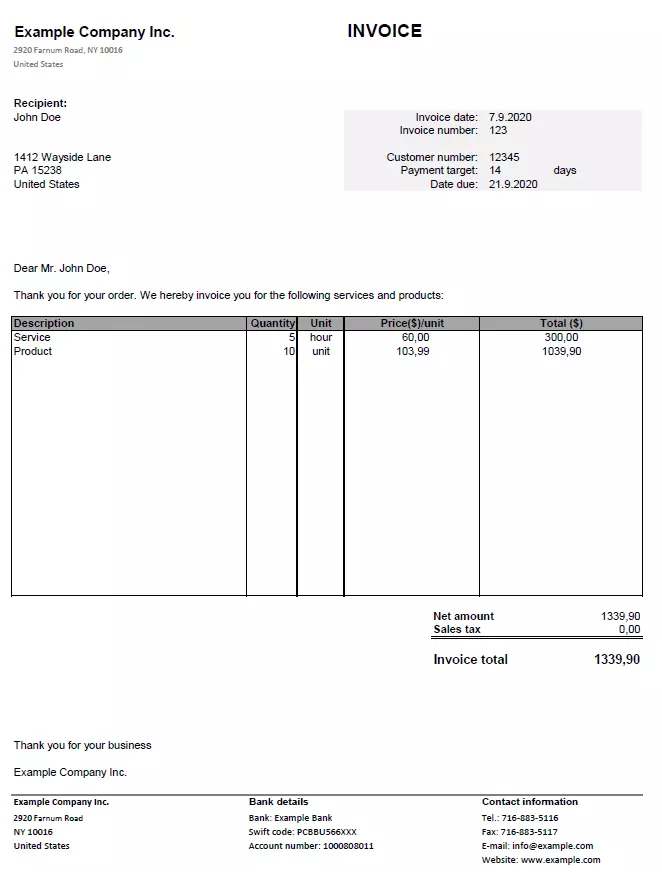Small business invoice
As a small business owner, you will be aware that you have to invoice your clients in order to receive your money and maintain an organized cash flow to keep everything running smoothly. Creating a professional-looking small business invoice isn’t difficult, but we’ve compiled a list of what to include to help you out.
What qualifies as a “small business”?
The US government has a say in what counts as a small business. The size standards have been established by the SBA (Small Business Administration) and define the maximum size that a company (including affiliates) can be to qualify as a small business. Whether you run a sole proprietorship, LLC, partnership, or corporation, the SBA either looks at the number of employees over the last 12 months or at the average annual receipt for the past three years to determine if the business falls into the small category. The two most used standards for qualifying a business as small are 500 employees for the majority of manufacturing and mining industries, and $7.5 million in average annual receipts for many non-manufacturing industries.
These small business criteria also need to be fulfilled in order to determine a company’s size – the business:
- Is organized for profit
- Has a place of business in the United States
- Is independently owned and operated
- Is not dominant in its field on a national basis
- Operated mainly within the U.S. or at least makes a significant contribution to the economy
What needs to be included in a small business invoice
There’s no right or wrong way to create a small business invoice, but it is essential that it includes all the important information between you and your clients.
Your business name and contact information
The client needs to know who they’re paying and that’s why your business name, address, e-mail, phone number, and website are an important part of the small business invoice, just as on any other kind of business correspondence.
Your client’s name and contact information
The client or customer’s name (or at least the contact person if it’s a large company) should be listed along with as much information on them as possible.
The invoice number
Each invoice has a unique number so it can easily be referred to if needed. It’s up to you how you number the invoices. It could be that you don’t want the first client to see that they’re #0001 so you might want to assign them a different number or even a code which is unique to each company e.g. #CLIENTA0020.
The PO number (if applicable)
Some bigger companies will want you to include a PO (Purchase Order) number on their invoice. A PO number uniquely identifies a purchase order/invoice and is usually defined by the client. This makes it easier when the client purchases a subscription and provides a PO number, since all invoices associated with that subscription can be grouped together for a better overview.
The invoice send date and due date
Include the date that the invoice was sent as well as the date that the payment is due so there are no misunderstandings.
Products or services provided
You should list a description for each product or service that you’ve sent or provided the client. For products, this means listing each item purchased, the quantity, the price per item, and the total price. When it comes to a service, you should write down the flat fee or the hourly fee (depending on what was discussed in advance), and the total hours it took.
Total amount to be paid
Once you’ve itemized everything and totaled up the amount due, don’t forget to add the appropriate tax, then write the final amount underneath.
Payment terms
Specify when you expect payment to be received by. If the service you’ve provided comes with a deposit then this also needs to be addressed. If the client misses the deadline, will they incur a fee?
Notes for the client (if applicable)
If you wish, you can leave a message for the client, maybe a quick “thank you for doing business with us.” Finish it off with your company logo, since this makes your business more recognizable, as well as using your business’ color scheme for the invoice.
How to send an invoice
You can send your invoice by mail, but nowadays e-mail is the more common way since the small business invoice will arrive much faster and there’s less chance of it getting lost along the way. There are also some extra steps you can take to make sure the whole process goes as smoothly as possible. You could call the client after you’ve sent the invoice to make sure they understand it and don’t have any questions about its content. Since you can never be too sure about security online, it makes sense to send the invoice in an un-editable format, e.g. PDF, so criminals can’t intercept it and change the bank details to their own in order to receive the money.
How long to keep an invoice
The Internal Revenue Service (IRS) recommends businesses keep any invoices they create in case they are audited and need to prove the validity of profit. If a dispute arises between the company and a client, it’s also good to have all the invoices saved so they can be quickly accessed and the matter solved. By keeping your invoices as organized as possible, you can better balance your budgets as well as manage your business’ accounts payable and accounts receivable functions.
Small business invoice template
The following example shows an invoice from the fictitious small business, Example Company LLC. You can download the template and customize it for your own invoicing.
Click here for important legal disclaimers.
